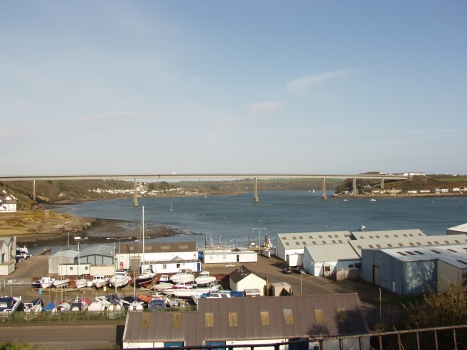General Information
| Other name(s): | Milford Haven Bridge |
|---|---|
| Beginning of works: | 1967 |
| Completion: | 20 March 1975 |
| Status: | in use |
Project Type
| Structure: |
Box girder bridge |
|---|---|
| Function / usage: |
Road bridge |
| Material: |
Steel bridge |
| Support conditions: |
for registered users |
| Plan view: |
Structurae Plus/Pro - Subscribe Now! |
| Material: |
Structurae Plus/Pro - Subscribe Now! |
Location
| Location: |
Milford Haven, Pembrokeshire, Wales, United Kingdom |
|---|---|
| Address: | A477 |
| Coordinates: | 51° 42' 23.09" N 4° 56' 0.16" W |
Technical Information
Materials
| piers |
reinforced concrete
|
|---|---|
| girder |
steel
|
| abutments |
reinforced concrete
|
Chronology
| 2 June 1970 | Bridge collapses during construction killing four men. |
|---|
Excerpt from Wikipedia
The Cleddau Bridge (pronounced [ˈklɛðai], Welsh:Pont Cleddau) in Pembrokeshire carries the A477 road, and was originally called the Milford Haven Bridge. It spans the River Cleddau between Neyland and Pembroke Dock, South Wales.
Errors in the box girder design caused it to collapse during its construction in 1970. The bridge became operational during 1975. The bridge is managed by Pembrokeshire County Council.
History
Pembrokeshire is divided by the Cleddau; Hobbs Point in Pembroke Dock on the south side and Neyland on the north side are less than 1 mile (1.6 km) apart across the waterway but a journey of 28 miles (45 km) by road is required to travel from one to the other. Between 1858 and 1950, the Admiralty permitted operation of steam ferries between the two towns. From 1950, the County Council operated a ferry service, with capacity for 24 vehicles and 250 pedestrians.
A decision was taken in the 1960s to replace the ferry service: two bridges would be required, one crossing the Cleddau and a smaller bridge to the north of Neyland crossing Westfield Pill creek. Sir Alexander Gibb & Partners and Freeman Fox and Partners (now part of Hyder Consulting) were appointed as joint consulting engineers and the contract to build the bridge was awarded to A.E. Farr Limited in September 1968 for £2.1 million.
The project was expected to be completed by March 1971 but on 2 June 1970 a 230 feet (70 m) cantilever being used to put one of the 150-tonne sections into position collapsed on the south side of the estuary. Four workers died and five were injured. Construction was halted until October 1972. The Merrison Committee of Inquiry into the Design and Erection of Steel Box Girder Bridges concluded that the cause of the collapse was the inadequacy of the design of a pier support diaphragm (a diaphragm of half the designed thickness was used), but considered "the failure of site organisation between the parties as of more general significance". The committee believed that the only relevant Code of Practice relating to the design of steel bridges in the UK was inadequate for applications such as the Cleddau Bridge, and they implemented Interim Design and Workmanship Rules. These rules lay the groundwork for a new British Standard covering box girder bridge design. As of 2007, the collapse during construction is regarded as the last major bridge disaster in the UK.
The final cost of construction was £11.83 million and the bridge was opened to traffic on 20 March 1975. The £7 million of overspend was attributed to design changes made due to the Merrison Committee's recommendations. This was covered by a £3 million out-of-court settlement between the County Council and the consulting engineers and a £4 million interest-free loan from the Government that was repayable over 40 years. 885,900 crossings were made during the bridge's first year in operation.
The ferry service between Hobbs Point and Neyland ceased when the construction of the Cleddau Bridge was completed in 1975. The ferry Cleddau King was sold, modified by Harland and Wolff of Belfast and put into operation as a reserve Portaferry–Strangford ferry in Northern Ireland.
Formerly, tolls were collected on the south side of the bridge from traffic travelling in both directions. Toll booths with barriers were introduced in September 2004 to reduce the number of vehicles driving through without paying. The bridge has been toll-free since 28 March 2019.
Closures
The county council may close the bridge depending on wind speed, wind direction and the weather forecast. Vehicles taller than 1.9 m (6 ft 3 in), bicycles and motorcycles are usually not permitted to cross the bridge when wind speeds exceed 50 mph (80 km/h). The bridge is closed to all vehicles and pedestrians should wind speeds exceed 70 mph (110 km/h). The council records the time the bridge is closed.
Text imported from Wikipedia article "Cleddau Bridge" and modified on July 23, 2019 according to the CC-BY-SA 4.0 International license.
Participants
Relevant Web Sites
Relevant Publications
- (1999): The Creation of Bridges. From vision to reality - the ultimate challenge of architecture, design and distance. Aurum Press, London (United Kingdom), pp. 232.
- : A History of Horseley, Tipton. Two centuries of Engineering Progress. United Kingdom (United Kingdom), pp. 176.
- (2016): Long-term structural health monitoring of the Cleddau bridge: evaluation of quasi-static temperature effects on bearing movements. In: Structure and Infrastructure Engineering, v. 12, n. 10 (October 2016), pp. 1342-1355.
- About this
data sheet - Structure-ID
20013644 - Published on:
03/10/2004 - Last updated on:
27/10/2021






